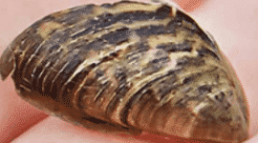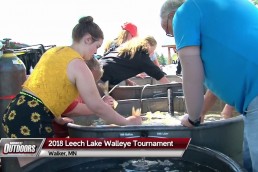SHARE THIS POST
Zebra mussels are a small, invasive mollusk (clam) that originated in Eastern Europe and first arrived in the U.S. in the mid-1980s. Though usually less than an inch in size as adults, they can rapidly spread under the right conditions. These mussels can clog irrigation lines and damage boat motors and docks, and their sharp shells can wash up on shorelines in large numbers making recreation difficult. The larval stage of zebra mussels, called “veligers,” are nearly impossible to detect due to their small size, heightening the importance of the state’s boat draining laws. Veligers can be easily transported to new waters in a small amount of water remaining anywhere in a boat or watercraft after a fishing or boating trip.
Boaters enjoying South Dakota’s McCook Lake should be aware that the body of water is now classified as “infested” with zebra mussels by the South Dakota Game, Fish and Parks (GFP). Special precautions are necessary to prevent spreading mussels to other waters.
Members of the McCook Lake Association performing maintenance prior to Memorial Day Weekend initially discovered the mussels. Additional sampling efforts by the GFP have confirmed adult zebra mussels exist in multiple areas throughout the lake.
In August 2015, zebra mussels were present and reproducing in large numbers in Lewis and Clark Lake near Yankton, S.D. This prompted a collaborative effort by multiple local, state and federal agencies from South Dakota and Nebraska to address the problems these mussels create. Boat inspections and enforcement efforts have been increased to ensure boaters are complying with regulations.
At a recent checkpoint on Lewis and Clark Lake, a number of individuals entered the ramp area towing their boats with their plugs still in place and they received citations.
Are you enjoying this post?
You can be among the first to get the latest info on where to go, what to use and how to use it!
“Anglers and all recreational boaters need to understand that once they remove their plugs they must remain out until just prior to launching on a subsequent trip on the water,” said Emmett Keyser, GFP southeast regional supervisor. “The boating public is one of our essential allies in helping to prevent the spread of aquatic invasive species and we want to remind them they must leave their plugs out and drains open at all times when they are not on the water.”
Completely draining a boat is the first step to ensure aquatic invasive species are not transferred to other waters. Anglers and boaters using zebra mussel-infested waters should clean their boats with 140-degree water and let them completely dry before launching their boats in uninfested water bodies.
“Right now, South Dakota waters are beginning to reach peak water temperatures for juvenile veligers to spread,” said John Lott, GFP chief of aquatic resources. “Anglers and boaters need to be extra diligent and completely drain their boats before leaving boat ramp areas.”
For more information on zebra mussels and other aquatic invasive species visit sdleastwanted.com.
MWO
SHARE THIS POST
Did you enjoy this post?
You can be among the first to get the latest info on where to go, what to use and how to use it!
MWO
We believe being outdoors is good. With more than 1,000 articles each year, MidWest Outdoors magazine is all about sharing outdoor experiences with you—where to go, what to use and how to use it… whether you’re close to home or on that trip of a lifetime.



